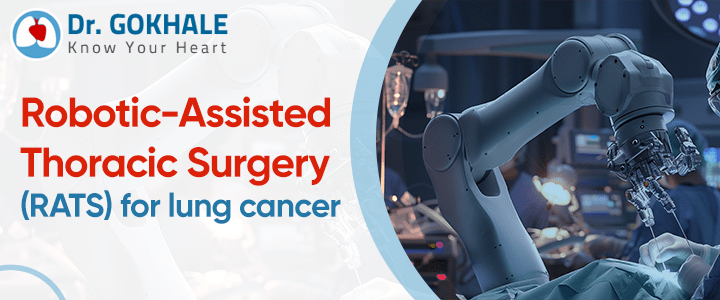For many patients, surgery is their best chance at improving survival. Traditionally, this translated to large incisions, long recovery times, and significant risks. However, due to modern medical advancements, the game has changed.
Robotic-assisted thoracic surgery, RATS, is a technique that combines precision robotics with minimally invasive surgery. This approach is gaining traction in lung cancer treatment because it offers patients better outcomes and fewer complications. But what is RATS? How does it work? Let’s get into it.
What is Robotic Assisted Thoracic Surgery (RATS)?
RATS is a type of minimally invasive surgery that makes use of a robotic system to help surgeons perform delicate procedures in the chest. Unlike traditional open chest surgery, thoracic surgery for lung cancer, which requires large incisions and spreading of the ribs, RATS allows for precise movements using small incisions.
Although called robotic surgery, the robot does not operate on its own. The surgeon is in complete control using the system to translate hand movements. It allows for greater accuracy, flexibility and control compared to traditional surgery.
Why is RATS a Preferred Option for Lung Cancers?
Many patients and doctors turn to RATS for lung cancer because there are several advantages over open surgery. Here’s why.
1.A smaller incision means less pain. Since RATS requires just a few small cuts, the patients will experience significantly less pain.
2.Greater precision. Robotic arms can make better-refined movements than a human hand, so it reduces the risk of damaging healthy lung tissue.
3.Faster recovery. When there is minimal trauma to the body, most patients recover faster and spend fewer days in the hospital.
4.Lower risk of complications. There’s a reduced chance of infection or excessive bleeding post-surgery.
How the RATS Procedure Works
i. Before Surgery: Preparation
Not all lung cancer patients would qualify for RATS. The decision is based on tumour size, location and viral health of the patients. A thorough evaluation involving CT scans and lung function tests will help determine if this is the right approach.
Ii. During Surgery: Step-by-Step Process
●Anesthesia. The patient is put under general anaesthesia and placed in a side-lying position.
●Small incisions. The surgeon makes three to four small cuts between the ribs.
●Robotic amnesia. The tiny robotic instrument and high-definition camera are then placed inside the chest.
●Tumor removal. With the robotic arm of the surgeon, we carefully remove the tumour and any affected lymph nodes.
●Closing up. After the incisions are removed, the incisions are stitched up.
Iii. After Surgery: Recovery
Most patients will spend just a few days in the hospital, usually shorter than when it is traditional surgery. Pain is usually mild, but most people return to their normal activities within a few weeks.
Conclusion
Robotic-assisted surgery shows a great leap in lung cancer treatment. With smaller incisions, faster recovery, and better precision, more patients and doctors will pick RATS over traditional surgery. For patients who are considering surgery, a lung transplant in India could be a life-changing option. If you are unsure if this procedure is best for you, do well to consult Dr. Gokhale today.
 Ask Doctor
Ask Doctor
